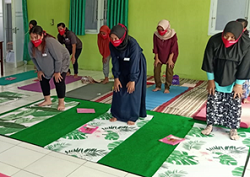Implementasi Senam Hamil Gerakan Sholat dalam Normalisasi Denyut Jantung Janin Implementation of Prenatal Exercise with Prayer Movement in Normalization of Fetal Heart Rate
Main Article Content
Abstract
Anxiety that is not resolved immediately in pregnant women and the inability to regulate the breathing pattern can affect the condition of the intrauterine fetus, so it must be addressed immediately. The number of pregnant women who have a gestation of more than 20 weeks at Limbangan Community Health Center is 20 people. Fetal Heart Rate (FHR) at arrival ranges from 120-160 x/minute; due to fatigue and inability to regulate breathing patterns, some pregnant women feel anxious. The solution to this problem is aimed at normalizing the DJJ by doing pregnancy exercises, prayer movements. The implementation of activities with the application of science and technology was carried out twice, on 4 September 2020 and 2 October 2020, with the target of pregnant women at the Puskesmas Limbangan Kendal Regency. The form of science and technology transfer began with a pre-test and ended with a post-test; education was delivered in an easy-to-understand method, providing material on prenatal exercise with prayer movements. All participants also immediately performed pregnancy exercises during the prayer movements according to instructions from the proposing team. In addition, fellow participants also discussed and exchanged experiences about their pregnancies. FHR for pregnant women ranges from 130-150 x/minute after the prayer movements; participants feel calmer and more comfortable because their breathing patterns are regular. The most important thing in this activity is that the mother will teach other pregnant women.
Downloads
Article Details
Authors who publish with this journal agree to the following terms:
- Any article on the copyright is retained by the author(s).
- Author grant the journal, right of first publication with the work simultaneously licensed under a Creative Commons Attribution License that allows others to share work with acknowledgment of the work authors and initial publications in this journal.
- Authors are able to enter into a separate, additional contractual arrangements for non-exclusive distribution of published articles of work (eg, post-institutional repository) or publish it in a book, with acknowledgment of its initial publication in this journal.
- Authors are permitted and encouraged to post their work online (e.g., in institutional repositories or on their websites) prior to and during the submission process, as can lead to productive exchanges, as well as earlier and greater citation of published work.
- The article and any associated published material is distributed under the Creative Commons Attribution-ShareAlike 4.0 International License
References
Doufesh, H., Ibrahim, F., Ismail, N.A., Wan Ahmad, W.A. 2014. Effect of Muslim prayer (Salat) on α electroencephalography and its relationship with autonomic nervous system activity. The Journal of Alternative and Complementary Medicine. 20(7):558-562. https://doi.org/10.1089/acm.2013.0426
Habibi, A.A., Hasbi, A. 2015. Kesehatan Spiritual dan Ibadah Shalat Dalam Perspektif Ilmu dan Teknologi Kedokteran. Medika Islamika: Jurnal Kedokteran, Kesehatan dan Keislaman. 12(1):61-83.
Kheirkhah, M., Pour, N.S.V., Nisani, L., Haghani, H. 2014. Comparing the Effects of Aromatherapy With Rose Oils and Warm Foot Bath on Anxiety in the First Stage of Labor in Nulliparous Women. Iranian Red Crescent Medical Journal. 16(9):e14455. https://dx.doi.org/10.5812/ircmj.14455
Meiranny, A., Wulandari, RR.C.L., Rahmawati, A., Jannah, M. 2019. Penurunan Kecemasan Kehamilan melalui Kelas Prenatal. PengabdianMu: Jurnal Ilmiah Pengabdian kepada Masyarakat. 5(1):33-38. https://doi.org/10.33084/pengabdianmu.v5i1.939
Pieter, H.Z, Lubis, N.L. 2010. Pengantar Psikologi Untuk Kebidanan. Jakarta: Kencana Prenada Media Group.
Sari, S.M. 2003. Peran Warna Pada Interior Rumah Sakit Berwawasan ‘Healing Environment’ Terhadap Proses Penyembuhan Pasien. Dimensi Interior: Jurnal Desain Interior. 1(2):141-156. https://doi.org/10.9744/interior.1.2.pp.%20141-156
Sudarso, S. 2018. Pengaruh Gerakan Sholat Terhadap Penurunan Tingkat Kecemasan Dan Tekanan Darah Pada Penderita Hipertensi Di Panti Werdha Mojopahit Brangkal Mojokerto. Thesis. Yogyakarta: Universitas Muhammadiyah Yogyakarta.
Tyastuti, S., Wahyuningsih, H.P. 2011. Asuhan Kebidanan Kehamilan. Jakarta: Pusat Pendidikan Sumber Daya Manusia Kesehatan Badan Pengembangan dan Pemberdayaan Sumber Daya Manusia Kesehatan.
Widianti, A.T., Proverawati, A. 2010. Senam Kesehatan. Yogyakarta: Nuha Medika
Winarni. 2014. Kepuasan Ibu Hamil Terhadap Pelayanan Antenatal Care (ANC) Oleh Bidan Di Wilayah Kerja Puskesmas Ngoresan. Gaster. 11(2):69-79.
Wulandari, P.Y. 2006. Efektivitas Senam Hamil sebagai Pelayanan Prenatal dalam Menurunkan Kecemasan Menghadapi Persalinan Pertama. INSAN. 8(2):136-145.
